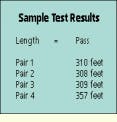Test the length of hybrid-cable constructions to ensure accuracy
John Schnecker and Mike Longo
RCDD
Anixter Inc.
Problem
Length results may be erroneous when you are testing plenum cables comprising different insulation materials between pairs (hybrid construction); for example 3x1, 2x2 cable construction, where one or two cable pairs are insulated with a material other than fluorinated ethylene propylene, or FEP. Most test equipment restricts the user to choosing one nominal velocity of propagation, or NVP, per cable. In hybrid constructions, the NVP can vary significantly by cable pair. Therefore, using one NVP for the entire cable may produce unacceptable results, even when an overall Pass is obtained during testing.
Solution
Test units may eventually include the capability to input a separate NVP per cable pair. (A device with this capability will probably be available by press time.) In the meantime, you should run a separate length test for the small percentage of links that obtain an overall Pass, yet show individual lengths exceeding Telecommunications Industry Association/Electronic Industries Association standard 568A limits.
Procedure
1) When using cable with different insulation between pairs, first contact the manufacturer for an accurate list of the NVP per individual pair.
2) Run autotests with the unit set at the correct NVP for the pairs that have FEP insulation. (The FEP pairs usually have higher NVPs, resulting in the shortest electrical delay. This is the basis for Pass/Fail, as stated in TIA/EIA Telecommunications Systems Bulletin 67.)
3) You will find that any pair measured to be shorter than 295 feet for a basic link or 328 feet for a channel link produces an overall Pass for the length measurement.
4) The non-FEP pair(s) may, in fact, be reported as longer than these distance limitations. To correct this error, change the NVP in the test unit to reflect the NVP of the non-FEP pair(s). Also restrict the unit to testing only the non-FEP pair(s).
5) Run another length test.
This test should report results that are more accurate and comparable to the results from the FEP pairs in the first autotest.
John Schnecker is a product manager and Mike Longo, RCDD, is technical marketing manager at Anixter Inc., Skokie, IL.

